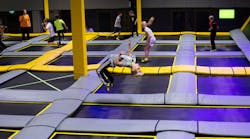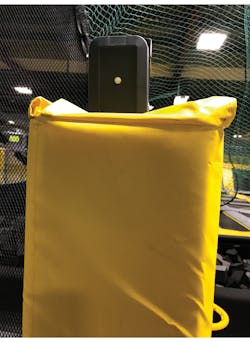Download this article as a .PDF
When you think about enterprise Internet of Things (IoT), what comes to mind? Industrial settings like factories, maybe? Mission-critical environments like data centers, perhaps? How about wireless sensors that measure pressure, vibration, and more on massive machinery and expensive equipment? It’s unlikely that the first thing that would come to mind is a trampoline park full of kids who are bouncing, bouncing, bouncing, and then asking their parents if they saw that amazing flip they just executed to perfection.
What about LoRa networks? What comes to mind when you think about the way that LoRa technology is being used in IoT implementations? Chances are that you are envisioning remote locations where industrial equipment resides in far-off settings, where only the long-distance capabilities of LoRa would make sensor networks practical. Again, it’s unlikely that you would envision LoRa-based networks in an urban fun center with adults and coworkers competing to do the farthest bounces from one trampoline to the next.
And yet, that is exactly what’s happening at an expectations-busting IoT implementation at a Freedome trampoline park in the U.K. This project has significant implications for enterprise IoT overall because it opens up a new world for how low-power sensor networks with LoRa can be utilized.
The IoT and Trampolines
First, let’s bring you up to speed on Freedome, which is a new concept for indoor trampoline parks from the company that invented the concept, Sky Zone. Freedome is an aerial freestyle park that combines trampolines with sports activities, physical challenges, digital technology, and a multimedia environment, creating a unique play experience for kids and adults alike.
Freedome uses technology in ways that have never been part of trampoline parks before, creating fun, digitally-driven challenges for participants while also creating a dynamic audio and visual experience. But the technology isn’t just for visitors’ entertainment. The use of technology also extends to Freedome’s operational management. In particular, IoT sensors play a critical role in the way the company manages its day-to-day operations and supports its growth strategy.
Freedome wanted to use technology to ensure the safety of visitors while also learning as much as possible about which activities are the most fun. The company could then evolve the design and amplify the fun. Discussions then began with a company called Sensorstream that centered on how to use wireless sensors to address these needs. Sensorstream is a U.K.-based firm that is doing groundbreaking work in the deployment of IoT networks. Some key objectives came to the forefront:
- Ensure the safety of visitors by utilizing sensors to:
- Monitor that children do not accidentally go into restricted areas like underneath the trampolines, into employee-only areas, or other locations with safety concerns.
- Track that proper safety protocols are followed for maintenance and operations of all trampolines and other equipment.
- Enhance the design of the facility to deliver more of what visitors enjoy by:
- Learning which activities visitors utilize the most, monitoring for novel ways that visitors are enjoying the activities, and gathering other useful information about usage patterns.
- Then translating that business intelligence into actionable decisions about how to enhance the design of the facility.
Those last two objectives will likely resonate with anyone involved in enterprise and industrial IoT because they mirror two of the primary reasons why every company uses sensor networks: safety and operational efficiency/improvement. With those objectives in mind, the traditional prescription would have been to implement a short-range, low-power sensor network. However, Sensorstream went in a very different direction, and in doing so has opened up a new realm of applications for LoRa technology.
Fundamentals of LoRa
As context for readers who are less familiar with the technology, LoRa provides secure, bi-directional data transfer and communications with IoT networks over long distances, and over the course of years, without a battery change. It can send and receive signals up to 10 miles—and that distance can extend to hundreds of miles with additional gateways, if needed. LoRa is often referred to as a low-power wide-area-network (LPWAN).
LoRa nodes are also inexpensive, allowing companies to create a low-cost backhaul network that bypasses fiber or cell service. Thus, they are able to avoid the high cost of building fiber to a remote site or the cost of a cell contract. These costs can be expensive for the kind of connectivity an IoT deployment necessitates.
LoRa is also highly scalable and interoperable, and is compatible with both public and private networks for the data backhaul and bi-directional communications. One of its best qualities is the ability to perform in harsh RF environments with vibration, interference, extreme temperatures, etc. These conditions are quite common in industrial environments and remote locations where the elements can go to extremes.
The attribute of LoRa that typically gets the most attention is the long-distance capabilities, which make it ideal for remote installations that may be miles or hundreds of miles from traditional telecommunications infrastructure. While that is indeed a valuable attribute for geographically remote projects, LoRa has other attributes that give it a much broader set of applications (like the Freedome implementation in an urban setting). These attributes include:
- Remarkable power usage efficiency that makes them a very low maintenance option, requiring very infrequent battery changes
- A low overall bill-of-materials (BOM) cost that makes it possible for organizations to implement a large number of sensors while still staying within a modest project budget
- Simplicity of installation and connectivity, allowing a “stick-and-go” rollout rather than a complex, drawn-out process of installing the sensors and getting them properly networked
- The ability to operate reliably in complex wireless environments, such as urban settings, where RF “noise,” electrical interference, and physical objects create so many problems for other technologies
- Ease of repeating these installations at other locations as the company expands in Europe and globally
- And “baked-in” security that differentiates it from other IoT technologies, making it a good match for corporate security policies
LoRa may not be the first technology that comes to mind for this type of application. However, attributes like its energy efficiency, near-immunity to interference, enterprise-grade security, and ease of implementation made it ideal for the Freedome project. Sensorstream’s implementation used its rugged, stick-and-go Sensor Action Monitors and Action Links connected together with a Sensorstream Wide Area Network.
The devices are easily deployed without the need for complex RF expertise (see figure). They can be repositioned without difficulty to monitor new areas as needed. The sensors and WAN utilize Laird’s Sentrius RM1xx LoRa + BLE module as a foundational technology. LoRa works well as a complement for BLE in battery-powered networks of IoT devices because it can operate for an extended time on a battery and requires very infrequent maintenance—just like BLE.
How Sensors Can Enhance a Trampoline Park
Sensorstream has completed an implementation of a LoRa-based IoT network at one of Freedome’s U.K. locations as a pilot project for a potential large-scale rollout. The sensor environment collects and reports a variety of motion and access data in real time to each facility’s staff, alerting them if visitors have ventured into an unauthorized area. The alerts are delivered via smartphone to staff members, who can respond immediately and ensure that children stay where they should be and keep on bouncing.
The sensors are also used as an audit trail to ensure that staffers are conducting the safety checks and maintenance protocols that must be done on hourly, daily, weekly, or less frequent schedules. They also provide alerts concerning other real-time operational issues that may need immediate response. In addition, the sensors deliver information related to environmental conditions in different areas of the trampoline park. Temperature and humidity alerts are provided that prompt heating and cooling adjustments to ensure visitor comfort.
By using LoRa, the sensors are able to operate reliably even in an electrically cluttered indoor environment without the need for expensive infrastructure. This is particularly important given the urban/suburban geographic location of the facilities with an abundance of competing wireless signals nearby.
It is also important given the physical shape of the building, the layout which presents physical obstructions that would ordinarily create difficulty for RF signals, the high number of consumer devices that visitors bring into the facility each day, and a Wi-Fi-intensive environment that so often creates difficulty for IoT networks. While LoRa’s long-distance capabilities often get top billing, the technology’s capability to successfully operate even in “cluttered” environments make it invaluable for much more than remote locations.
The Sensorstream IoT network also provides business intelligence that is playing an important role in helping Freedome enhance visitors’ experience over time and grow the company. The sensors collect data with regard to activity usage and behavioral patterns that are easily interpreted in the form of heat maps and other graphical information. By understanding which activities visitors enjoy the most, the company is able to deliver more of what people want through insights from data analysis rather than traditional, unreliable questionnaires.
This intelligence is captured throughout the day for each facility. It is accessible any time via a web dashboard, giving the company the ability to analyze current data against historical data and make informed decisions about design enhancements and operational changes. Not only would customers at existing trampoline parks be better served, but also future customers at new facilities that are being planned as the company grows. Freedome is also using this information to guide its marketing activities, highlighting activities within the park that resonate most with consumers and that encourage past patrons to return.
The ultra-long battery life makes LoRa-based sensors easier to maintain than other types of wireless sensors that require battery replacements more often. That is all the more important in a non-industrial environment like a trampoline park, where the staff does not include engineers whose daily job is to tend to monitoring equipment. In this way, LoRa takes IoT a step closer to the set-it-and-forget-it goal that engineers are striving for, with sensor networks that require attention as infrequently as possible. Energy consumption is one of the key advantages of LoRa that does not receive as much attention as it should, and it is an attribute that makes it very attractive for deployments where minimal battery replacements is a priority.
LoRa-based sensors also give Freedome enterprise-grade security built into its IoT networks that align with their corporate security strategy today and in the future. With many wireless technologies, security is an afterthought, bolted on after the fact to address vulnerabilities that emerge over time. In contrast, LoRa is the first sensor technology that includes enterprise-level security built in with encryption and other attributes. As a result, companies can have peace of mind that IoT networks will not be an open door for security breaches. As IoT security becomes a hot-button issue for more companies, this implementation for Freedome is a compelling example of how LoRa-based networks make security sense for enterprise that want to embrace IoT without fearing the traditional security tradeoff.
In so many ways, this IoT implementation goes against the grain of what you expect from a LoRa-based network and from an implementation in an urban/suburban setting. Not every company is a trampoline park like Freedome, but every company in urban locations faces a similar set of challenges related to the density of RF signals, the need for inexpensive stick-and-go installations rather than complex set-up and network initiation processes, the desire for wireless sensors to be worry-free for as long as possible through things like battery life, and enterprise-grade security that is built in from the start rather than bolted on in a series of fixes later on.
Not every company uses its IoT network to keep track of bubbly, giggling kids and kids at heart from ages 2 to 102, but Freedome’s implementation is a case study in how IoT networks using LoRa technology can be used for enterprise-class safety, operational efficiency, and business intelligence.


